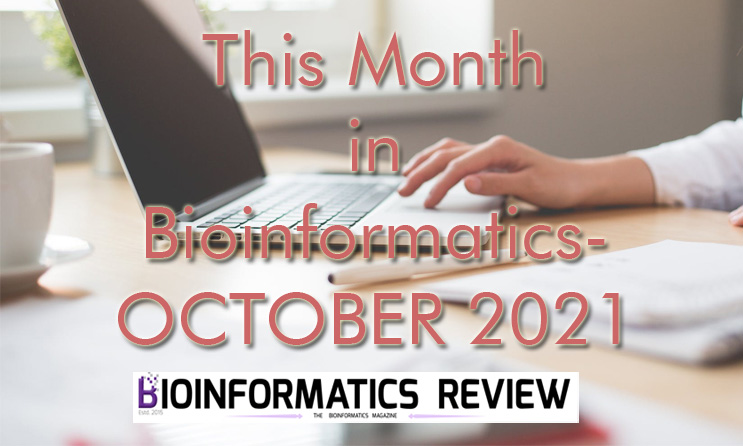Bioinformatics News
This Month in Bioinformatics- Research Updates of June 2021

In this article, we summarize the latest interesting findings made this month of June in bioinformatics.
1. A new package for continually updated phylogenetic trees using the open tree of life
A new Python package called Physcraper is developed [1]. This package is a command-line program that automatically updates the published phylogenetic trees. For doing so, it adds public DNA sequences to the alignments of previously published phylogenies. Users can also compare the old and the updated versions of phylogenies. For this purpose, it uses tools from the open tree of life project that links taxonomic information across databases [1]. It is accessible on Linux, Mac, and Windows and can be freely downloaded from https://physcraper.readthedocs.io/en/latest/index.html.
For more information, read here.
2. A new Cytoscape application for protein-protein interaction analysis
A new Cytoscape3 application known as StrongestPath is developed [2]. It is used for the interaction analysis of protein-protein or a group of proteins in a protein-protein interaction network or signaling network databases. StrongestPath extracts a set of possible interactions between the given set of proteins. Further, it adds new proteins to the network that have the most interactions with the highest total confidence to the current network of proteins. It uses interaction confidence scores to assign weights between 0 and 1 to each edge of the network [2].
StrongestPath is written in JAVA and is platform-independent. It can be downloaded from here.
For more information, read here.
3. A new database for integrated analysis of autoimmune diseases omics data
A new comprehensive database called Autoimmune Diseases Explorer is developed for the analysis of omics data of autoimmune diseases [3]. It integrates 82 curated transcriptomics and methylation studies and 5609 samples for some of the most common autoimmune diseases. The database is easy to use and provides statistical methods for advanced data analysis including pathway analysis, meta-analysis, and differential expression analysis [3]. The database is freely accessible at https://adex.genyo.es/.
For more information, read here.
4. A new long short-term memory method to predict the spread of covid19
A long short-term memory (LSTM) network method has been proposed to forecast the spread of covid19 [4]. It is based on a deep-learning approach that is a recurrent neural network with an LSTM layer. This method is proposed based on data obtained from New Zealand country, as it is the first country that has been able to completely contain the spread of covid19 and bring the daily cases to zero. This model is capable of predicting the estimated dates within which the spread of covid19 can be contained. The model was able to correctly predict the dates within which the spread of covid19 was contained in New Zealand.
For more information, read here.
5. A new tool for RNA-Seq data analysis
A new tool called RNAdetector [5] is developed for RNA-Seq data analysis. RNAdetector is a user-friendly stand-alone tool and a cloud-based platform that helps in RNA-Seq data analysis. It provides an easy-to-use graphical user interface that helps in analyzing coding and non-coding RNAs from RNA datasets. RNAdetector is a comprehensive pipeline that allows mRNAs and ncRNAs analysis including several classes of humans, C.elegans, and mice [5].
RNAdetector is freely available to download from https://rnadetector.atlas.dmi.unict.it/download.html. The source code is available on GitHub and the documentation can be found at https://github.com/alessandrolaferlita/RNAdetector/wiki/Requirements-and-Setup.
For more information, read here.
6. A new tool to visualize CRISPR screening experiments
A new web-based tool called VISPR is developed to visualize CRISPR screening experiments [6]. VISPR stands for VISualization of crisPR screens. It allows easy online analysis, visualization, and sharing of CRISPR screening data. VISPR also supports two other tools: BAGEL and JACKS. Additionally, VISPR allows users to visualize read count changes along with an interactive environment for gene exploration and viewing guide RNA locations [6].
VISPR is available for Linux, macOS, and Windows environments. It is freely accessible at http://vispr-online.weililab.org/ and the source is available on GitHub.
For more details, read here.
References
- Sánchez-Reyes, L.L., Kandziora, M. & McTavish, E.J. (2021). Physcraper: a Python package for continually updated phylogenetic trees using the Open Tree of Life. BMC Bioinformatics 22, 355.
- Mousavian, Z., Khodabandeh, M., Sharifi-Zarchi, A. et al. StrongestPath: a Cytoscape application for protein–protein interaction analysis. BMC Bioinformatics 22, 352 (2021).
- Martorell-Marugán, J., López-Domínguez, R., García-Moreno, A. et al. (2021). A comprehensive database for integrated analysis of omics data in autoimmune diseases. BMC Bioinformatics 22, 343.
- Kumar, S., Sharma, R., Tsunoda, T. et al. (2021). Forecasting the spread of COVID-19 using LSTM network. BMC Bioinformatics 22, 316.
- La Ferlita, A., Alaimo, S., Di Bella, S. et al. (2021). RNAdetector: a free user-friendly stand-alone and cloud-based system for RNA-Seq data analysis. BMC Bioinformatics 22, 298.
- Cui, Y., Wang, Z., Köster, J. et al. (2021). VISPR-online: a web-based interactive tool to visualize CRISPR screening experiments. BMC Bioinformatics 22, 344.
Bioinformatics News
Proteins shape analyses reveal novel forms and connections.

A new study has revealed new forms of proteins that have never been seen before along with unexpected connections. Last year, Google DeepMind predicted the structure of all known proteins from organisms using AlphaFold [1].
Bioinformatics News
What is MANE project?

MANE is a collaborative project between NCBI and EMBL-EBI. It stands for Matched Annotation from NCBI and EMBL-EBI [1]. The datasets provided by NCBI and EMBL-EBI on the human genome are not identical across every gene.
Bioinformatics News
This Month in Bioinformatics- Research Updates of March 2022

Here are the latest research developments in the field of bioinformatics made in the month of March 2022. (more…)
Bioinformatics News
This month in Bioinformatics- Research Updates of November 2021

We summarize the latest research published this month in the field of bioinformatics. (more…)
Bioinformatics News
This Month in Bioinformatics- Research Updates of October 2021

In this article, we summarize the latest interesting findings made this month in bioinformatics. (more…)
Bioinformatics News
BLAST+ 2.12.0- A more efficient version of BLAST is available

A new more efficient version of BLAST+ 2.12.o is available now [1]. This version provides more efficient multithreaded searches. (more…)
Bioinformatics News
This Month in Bioinformatics- Research Updates of May 2021

In this article, we summarize the latest interesting findings made this month in bioinformatics. (more…)
Bioinformatics Research Updates
This Month in Bioinformatics- Research Updates of April 2021

In this article, we summarize the latest interesting findings made this month in bioinformatics. (more…)
Bioinformatics News
This Month in Bioinformatics- Research Updates of March 2021

Here, we summarize the latest interesting findings made this month in bioinformatics. (more…)
Bioinformatics Research Updates
This Month in Bioinformatics- Research Updates of February 2021

We summarize the research done in bioinformatics in the month of February. (more…)
Bioinformatics Research Updates
This Month in Bioinformatics- Research Updates of January 2021

In this article, we summarize the main findings made in bioinformatics this month. (more…)
Bioinformatics News
This Month in Bioinformatics- Research Updates of December 2020

In this article, we summarize the latest research in bioinformatics published this month. (more…)
Bioinformatics News
Join Bioinformatics Review Research Group

We are going to lead a few bioinformatics research projects. For that, we are creating a new research group of Bioinformatics Review. (more…)
Bioinformatics News
This Month in Bioinformatics- Research Updates of November 2020

In this article, we summarize the latest research in bioinformatics published this month. (more…)
Bioinformatics News
This Month in Bioinformatics- Research Updates of October 2020

Some of the important findings made this month in bioinformatics are mentioned in this article. (more…)
Bioinformatics News
This Month in Bioinformatics: Research Updates of September 2020

Some of the important findings made this month in bioinformatics are mentioned in this article. (more…)
Bioinformatics News
This Month in Bioinformatics: Research Updates of August 2020

Some of the important findings made this month in bioinformatics are mentioned in this article. (more…)
Bioinformatics News
This month in Bioinformatics: Research Updates of July 2020

Some of the important findings made this month in bioinformatics are mentioned in this article. (more…)
Bioinformatics News
Inviting Nominations for ‘Top 5 Bioinformaticians in India 2020’

Bioinformatics Review compiles a list of top bioinformaticians every two years. We are inviting nominations for the second edition of this award after the 2018 List. We invite you to contribute to this endeavor by nominating your colleague or friends if you think they can make it to our list.
Nominations start from 20th June 2020 till 15th August 2020. All the nominees will be informed via email on 5th September 2020. We use a well-established ranking method called ScipRank. Our data collection is open-source. ScipRank methodology is publicly available for scrutiny.
Also, we are completing 5th year of success in Bioinformatics Review this year. On this occasion, we are organizing an International Conference on Advanced Research in Bioinformatics 2020. The award will be declared at the conclusion of ConARB 2020 – 3 & 4th Oct 2020).
We invite you to contribute to this endeavor by nominating your colleague or friends. You can also submit your papers, which if accepted, can be presented at the conference.
We have set up a dedicated portal for ConARB 2020 accessible here https://conarb.
To attend or to submit your abstract or to nominate someone, kindly visit this website. Accepted papers will be published in a special issue of Bioinformatics Review.
Bioinformatics News
A workshop on Genome Editing Tools and Techniques

Department of Biotechnology (DBT), India is organizing a 5-day workshop on “CRISPR/Cas mediated genome editing in plants: Applications, tools, and experimental design” to address the strategies and methods involved in genome modification utilized as essential tools in research and development. (more…)















You must be logged in to post a comment Login